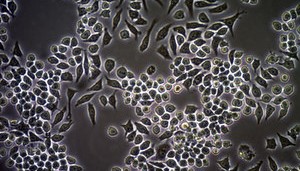Immortalized Murine Cells
 Murine cells show frequent spontaneous immortalization in contrast to human cells that almost never spontaneously immortalize. Addition of DNA tumor viruses alone, mild mutagen treatments and even deregulated expression of cellular genes such as c-myc are enough in certain murine cells for immortalization. Crisis stage is either not observed or is very subtle in case of murine cells, due to their ability to immortalize spontaneously, were exploited to identify genes associated with cellular mortal or immortal phenotypes. Independent studies on spontaneously immortalized clones from different strains of mouse have shown that most of these clones had one or both mutant p53 alleles, in contrast to their parent cells which expressed wild type p53. The immortal clones which expressed wild type p53 were found to be defective in one or other elements of the pRb pathway.
Creative Bioarray can provide you immortalized murine cell lines with an integrated platform for meeting the needs for virtually any relevant research project.
Murine cells show frequent spontaneous immortalization in contrast to human cells that almost never spontaneously immortalize. Addition of DNA tumor viruses alone, mild mutagen treatments and even deregulated expression of cellular genes such as c-myc are enough in certain murine cells for immortalization. Crisis stage is either not observed or is very subtle in case of murine cells, due to their ability to immortalize spontaneously, were exploited to identify genes associated with cellular mortal or immortal phenotypes. Independent studies on spontaneously immortalized clones from different strains of mouse have shown that most of these clones had one or both mutant p53 alleles, in contrast to their parent cells which expressed wild type p53. The immortal clones which expressed wild type p53 were found to be defective in one or other elements of the pRb pathway.
Creative Bioarray can provide you immortalized murine cell lines with an integrated platform for meeting the needs for virtually any relevant research project.
Description: Previously immortalized sertoli cells- involved in androgen regulation during spermatogenesis- lose ...
Description: Immortalized Mouse Schwann Cells are derived from Twitcher mice. The Schwann cells were ...
Description: Immortalized Mouse Distal Tubule KDT3 Cells are spontaneously immortal derived cells from murine ...
Description: A spontaneously immortalized cell clone arisen from isolated adipose-derived stem cells (ASCs), the ...
Description: Immortalized Mouse Subcutaneous Adipose Multipotent Mesenchymal Cells (m17.ASC-GFP) were ...
Description: The olfactory bulb is located within the vertebrate forebrain, in which it functions to receive ...
Description: The olfactory bulb is located within the vertebrate forebrain, in which it functions to receive ...
Description: The olfactory bulb is located within the vertebrate forebrain, in which it functions to receive ...
Description: Immortalized Mouse Floxed Fam20c Osteoblast Cells are a reliable tool to study osteoblasts and the ...
Description: The olfactory bulb is located within the vertebrate forebrain, in which it functions to receive ...
Description: The olfactory bulb is located within the vertebrate forebrain, in which it functions to receive ...
Description: The olfactory bulb is located within the vertebrate forebrain, in which it functions to receive ...
Description: Immortalized MHC II -/- Mouse Macrophage Cells (C2Dt) is derived from the knockout mice negative ...
Description: Immortalized Mouse Proximal Tubule KPT2 Cells are spontaneously immortal derived cells from murine ...
Description: Immortalized Rat Embryonic Striatal (M213-2O) Cells - tsSV40T has GABAgeric properties with ...
Description: The olfactory bulb is located within the vertebrate forebrain, in which it functions to receive ...
Description: Immortalized Mouse CD81−/− Macrophage Cells (ASD1) is established from the long bones of CD81 -/- ...
Description: Immortalized MHC II -/- Mouse Macrophage Cells (C2D) is derived from the knockout mice negative for ...